January 17, 2020 report
Using machine learning to fine-tune views of the ancient past

A team of researchers affiliated with several institutions in China and two in the U.S. has developed a way to use machine learning to get a better look at the past. In their paper published in the journal Science, the group describes how they used machine learning to analyze records of the past.
Scientists use fossils to date rocks because they have no way to test the age of rock directly. Prior research has shown that most species only exist for a certain amount of time. If scientists determine the time when a given dinosaur lived in a given area, they can use that information to date the local rocks using the fossils embedded within them. A drawback to this method of dating rocks is that it does not give scientists a very fine filter when attempting to create a timeline of historical events such as mass extinctions.
A decade ago, a group of mathematicians developed a statistical approach to creating a biodiversity timeline based on analyzing hundreds of thousands of records of marine and land fossils. Their method would have allowed scientists to divide the past several hundred million years into small spans of time. This would have provided a finer view of what has transpired. Unfortunately, it took dozens of months to run the programs—too long for practical use. In this new effort, the researchers have resurrected the work by the mathematicians by applying machine learning to the data and then analyzing the results on a Tianhe-2 supercomputer.
The researchers entered data covering approximately 300 million years—from the beginning of the Cambrian period, approximately 540 million years ago, until shortly after the Triassic period began, approximately 240 million years ago. The computer returned results for periods of time as short as 26,000 years. They compared the difference in resolution to looking at six months of people living during a given time period versus a century.
The researchers found the timeline produced by the computer differed in some ways from the timeline produced using longer periods of time. For example, one of the five great mass extinctions believed to have happened did not actually happen—it was more of a slow change in biodiversity.
More information: Jun-xuan Fan et al. A high-resolution summary of Cambrian to Early Triassic marine invertebrate biodiversity, Science (2020). DOI: 10.1126/science.aax4953
Journal information: Science
© 2020 Science X Network





















